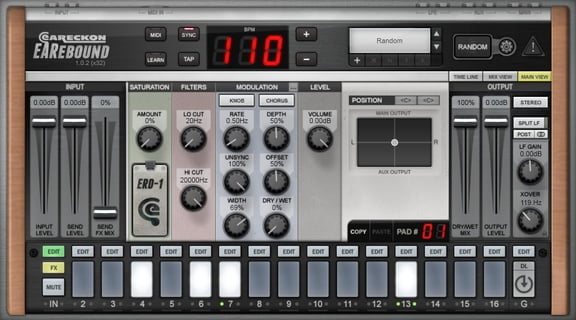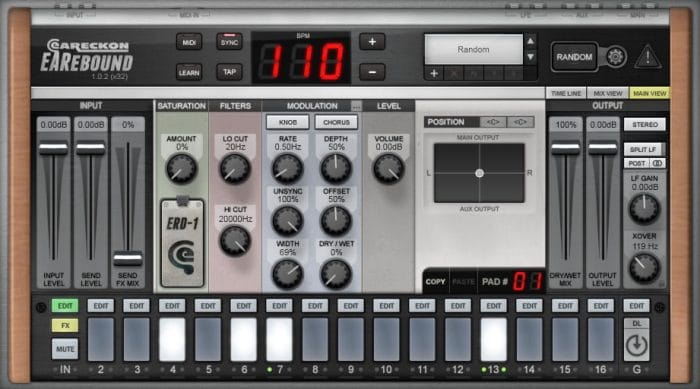Over the years I have collected a nice amount of delay plug-ins. My favorites include OhmBoyz, NastyDLA, ET-200, More Feedback Machine 2, Satin, ValhallaFreqEcho, RP-Delay, Sigmund, Timeless 2, Replika, … I’m probably forgetting some, but I guess it is clear I like my delays.
Some of these offer simple one-trick pony effects, others are capable of much more complex things.
The EARebound plug-in by eaReckon falls in the latter category.
It was originally designed to quickly create rhythm lines from percussive sounds recorded in various environments.
The idea behind EARebound was to create an effect featuring 15 delay lines and a workflow similar to the one provided by a good old drum machine. This tool had to offer 16 commutable and synchronized “steps”, with each of them being independently shaped and placed in space by a series of dedicated effects.
A confidential prototype was then born in 2011, offering 15 delay lines, a saturation module, two filters, a chorus and a positioning tool. This prototype was enough to create rhythm lines from any kind of recorded sounds within a couple of minutes. It was already lots of fun and saved time!
Further development of EARebound led to a solid multi-delay unit that excels in creating rhythm and spicing up your existing loops.
The interface of EARebound looks a bit like a groovebox/drum machine. The step sequencer in the bottom controls the input, 15 individual delay lines, and 1 global delay line.
The input can be muted and the fx applied to the source can be disabled as well. The steps in the sequencer have a solo button, and the global delay line can be set to either include or exclude the source input. The global line allows for looping the “sequencer pattern”. You can achieve some lovely creating special effects by using short delay times.
In the middle of the interface we find input & output controls on the left and right, with a handy section that lets you process low frequencies in various ways with stereo/multi-channel, split LF & pre/post parameters.
By clicking the edit button in the sequencer, you can set the effects for each of the delay lines (and the input). EARebound includes the following:
- 7 saturation/distortion units
- high-pass & low-pass filter
- modulation line with 4 chorus/tremolo lines
- level with feedback control
- position X/Y pad for panning and multi-channel output control
- and delay time with division multiplier (0-16x) and base division (up to 1/64 incl. dotted & triplet), and a knob to set the delay time manually.
All of these parameters can be adjusted from the main view, but if you want to see everything in one screen you can also use the mix view. This shows the effects applied to the input and 15 delay lines and you can modify parameters directly. In version 1.0.2 of EARebound, two Global Edit modes (same or relative value) were added, allowing you to edit parameters for all lines at the same time.
A third view shows a “Time Line” of delay times for the input and 15 delay lines. The circled points show output and feedback parameters, providing an intuitive overview of what’s going on exactly. Again, you can modify some parameters on the spot.
Other notable features include MIDI learn & control, a wonderful “Random” button (with optional parameter locks), and multiple stereo outputs, which allows the use of a 3rd party plug-in to process selected delay lines.
In the video below you can hear some of the presets on a simple melody done with u-he’s upcoming Hive synth.
So what do I think?
Format: VST/AU
Price: 99 EUR
Like: Deep & flexible, fun to use
Don’t like: —
Verdict: 9/10
Sometimes you want your delay effects quick and easy, other times you want to take it a step further and create something more deep and complex. EARebound does both, without ever getting complicated.
By including saturation & distortion models, filters and modulation options, EARebound is very flexible, offering much more than simple delay effects. The interface is very intuitive and a joy to work with.
Features like the alternate views, low frequency splitting and a “Random” knob that produces useful results show that some good thought was put into this plug-in.
In short, if you want a delay effect that offers both ease of use and extensive control, EARebound is definitely worth checking out.




